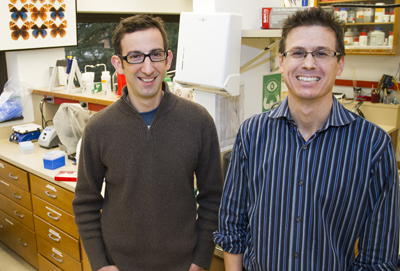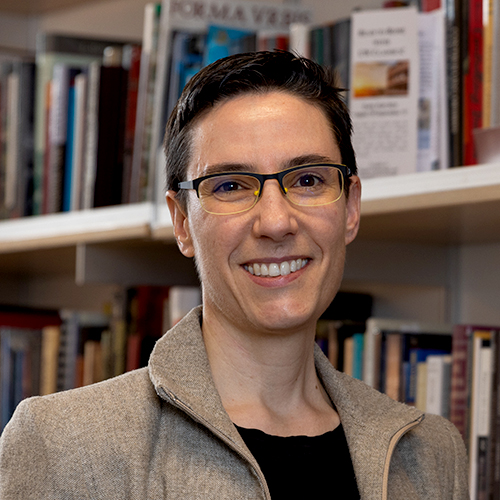Jay Parrish and Jeff Riffell are in the business of misleading mosquitoes. The UW Biology professors have spent the past 18 months rewiring insect brains to discern the olfactory prowess of our least favorite bloodsuckers.
“Chemical communication is the oldest sensory system and underlies nearly every critical ecological and evolutionary interaction,” Riffell explains.
In simpler terms, mosquitoes smell their prey. And there’s something about human scent that makes Homo sapiens blood particularly delectable to them. One of the many goals of Parrish and Riffell’s research is identifying the offending chemical. Since there are about 300 chemicals in our body odor, narrowing the pool to a singular insect appetizer is difficult, but the discovery would mean huge advances for disease control and…well, camping.

Once determined, Parrish envisions using the irresistible odor to set up scent traps at key geographic locations and testing the captured mosquitoes for carried disease vectors, like the West Nile Virus. It would be an aromatic early detection system. On the consumer side of things, products targeting the attractive smell alone would allow outdoor enthusiasts to mask it from mosquitoes without slathering plastic-melting DEET on their skin.
Such practical applications for the Biology Department’s research will come about in the not-so-distant future, but in the meantime Parrish and Riffell are consumed by the daily grind of mosquito microinjection and video monitoring. Alongside their mixed team of graduate and undergraduate students, the professors silence mosquitoes’ individual odor receptors through genetic means and then sit back and observe the fall-out. Tampering with the “right” receptors alters the mosquitoes’ behavior quite drastically. Specimens can become lethargic and disoriented, thrown by their inability to naturally track a blood reward. The team also is building tools to change the electro-chemical composition of the insects’ neurons; with these tools, small environmental changes in light and temperature will impede the firing of insect neurons, allowing the researchers to identify the regions of the mosquito that are involved in olfactory learning.
But pranking the mosquitoes’ noses is only half the story. Parrish and Riffell also examine how the insects’ altered processing of sensory information impacts their memory formation. What they’ve discovered is much bigger than better bug repellant. The added neurological impediments force the insects to recode their behavior—meaning that once impaired, mosquitoes simply find new ways to track their hosts or change their meal preferences altogether. In other words, they learn.
Yes, those insufferable nuisances buzzing around the campfire aren’t just driven by instinct. They can adapt new feeding techniques within a single life cycle. But as terrifying as the idea of improvisational bloodsucking is, Parrish and Riffell insist these neurological connections are a good sign. They show that parallels can be drawn between the cognitive processes of insects and humans, illuminating the finer workings of both. And they have found that silencing neurons involved in memory formation can prevent the mosquitoes from learning.
“We’re reverse engineers—we take systems apart to figure out how they’re working,” Riffell says. By deciphering the intricacies of simpler organisms, the scientists hope to shed some light on the mutations of genes shared by species big and small. Doing so can ultimately help the treatment of cognitive diseases like Fragile X syndrome and Alzheimer’s disease.
Such a lucrative collaboration wouldn’t have been possible without the Biology Department’s interdisciplinary approach to research. Before coming to the UW, Parrish and Riffell ran in different scientific circles. The former specialized in cellular molecular biology, the latter in marine biology and animal behavior.
“We had gone to the same conferences, but just passed by each other,” Parrish recalls. Their orbits finally collided when the two joined the UW faculty. Bonding over their previous work with fruit flies, Parrish and Riffell embarked on this novel insect experiment.
Toby Bradshaw, chair of the department, strives to make these instances of “unexpected synergy”—like the Parrish/Riffell partnership—a UW standard.
“Real advances happen across the boundaries of biology, not in isolated specialties,” Bradshaw says. “It takes the right faculty and it takes the right shared space.”
More Stories

What the Sky Teaches Us
Brittany Kamai, an astrophysicist with knowledge of Pacific Islanders' Indigenous navigation using the sky, is teaching a new UW course, Pacific Indigenous Astrophysics.

Lifting Marginalized Voices — from Ancient Rome
"Interesting, frustrating, and necessary,” is how Sarah Levin-Richardson, professor of Classics, describes her research into the lives of enslaved individuals in the ancient world.

A Closer Look at Teens & Digital Technology
The impact of digital technology on teens' mental health is the focus of a new course developed by Lucia Magis-Weinberg in the UW Department of Psychology.